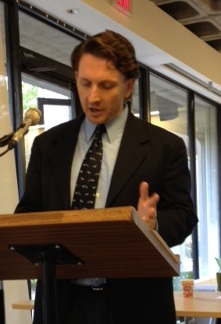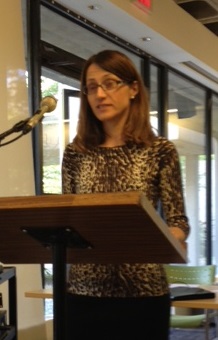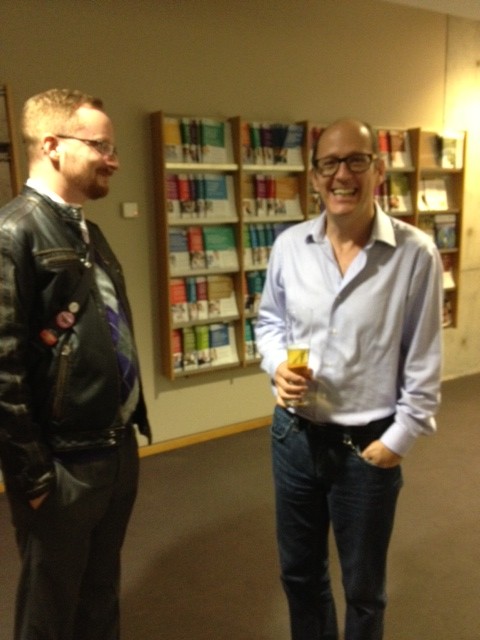The 2013 York Christian Apocrypha Symposium in Retrospect: Part Three
Day two of the symposium was intended as a look to the future. The first session featured several of the participants in the More Christian Apocrypha Project (MCAP), which is producing collections of apocryphal texts in English translation (some for the first time), primarily by North American scholars. These papers examined some little-known or under-appreciated texts and traditions. In the first presentation, F. Stanley Jones (California State University) examined “The Distinctive Sayings of Jesus Shared by Justin and the Pseudo-Clementines.” Jones is contributing two pieces for the first More Christian Apocrypha volume: the Syriac epitome of the Acts of Peter, and the Aramaic fragments of the Toledot Yeshu (which have not yet appeared in English translation). We have talked also of including some or all of the Ps.-Clementine corpus in a future volume, since the material has not appeared in English translation for almost 150 years. Jones noted in his talk that he has constructed a synopsis of the witnesses to the text but has not found a publisher for it; this is unfortunate because it would be an important resource for studying the text. As for Jones’s paper, it presents an argument against the view that the shared sayings derive from a gospel harmony; instead Ps. Clem. seems to have pulled them from Justin’s lost work Syntagma, which Justin wrote to refute Marcion. The sayings thus have a distinct Marcionite or anti-Marcionite flavour.
 Jones was followed by Stephen Shoemaker (University of Oregon), presenting on “The Tiburtine Sibyl, the Last Emperor, and the Byzantine Apocalyptic Tradition.” Shoemaker is contributing a piece on the Tiburtine Sibyl, along with a new translation of the Apocalypse of the Virgin, to the MCA volume. For many people in the room, this paper was their first exposure to this text, though it was widely popular in the Middle Ages, has a healthy manuscript base, and deeply influenced medieval culture (Shoemaker says it was “more influential on medieval eschatology than the canonical Apocalypse”). Nevertheless, it is rarely included in collections of Christian Apocrypha (Erbetta’s expansive collection is the exception), chiefly because it is a relatively late composition (late fourth century). Shoemaker thus called the text an example of “non-canonical apocrypha,” and cautioned us to be careful of allowing the CA collections to limit our studies to the standard texts (indeed, MCAP is designed specifically to expand scholars’ awareness of the range of apocryphal literature). An important feature of the Tiburtine Sibyl is its description of the Last Emperor, a figure identified with Constantine who, the Sibyl says, will “devastate all the islands and cities of the pagans and destroy all the temples of idols.” Shoemaker argues that the Sibyl’s description of this figure may have influenced early Islamic eschatology.
Jones was followed by Stephen Shoemaker (University of Oregon), presenting on “The Tiburtine Sibyl, the Last Emperor, and the Byzantine Apocalyptic Tradition.” Shoemaker is contributing a piece on the Tiburtine Sibyl, along with a new translation of the Apocalypse of the Virgin, to the MCA volume. For many people in the room, this paper was their first exposure to this text, though it was widely popular in the Middle Ages, has a healthy manuscript base, and deeply influenced medieval culture (Shoemaker says it was “more influential on medieval eschatology than the canonical Apocalypse”). Nevertheless, it is rarely included in collections of Christian Apocrypha (Erbetta’s expansive collection is the exception), chiefly because it is a relatively late composition (late fourth century). Shoemaker thus called the text an example of “non-canonical apocrypha,” and cautioned us to be careful of allowing the CA collections to limit our studies to the standard texts (indeed, MCAP is designed specifically to expand scholars’ awareness of the range of apocryphal literature). An important feature of the Tiburtine Sibyl is its description of the Last Emperor, a figure identified with Constantine who, the Sibyl says, will “devastate all the islands and cities of the pagans and destroy all the temples of idols.” Shoemaker argues that the Sibyl’s description of this figure may have influenced early Islamic eschatology.
 The final two papers of the session were “Backstories of the Bandits: The Emergence, Submersion and Re-emergence of the Cult of Dysmas” by Mark Bilby (University of San Diego) and David Eastman’s (Ohio Wesleyan University) “Confused Traditions? Peter and Paul in the Apocryphal Acts.” Bilby, like Shoemaker, brought attention to a little-studied apocryphon—though this one is an “orphan story” with versions appearing in a variety of sources, including manuscripts of Pseudo-Matthew and the Gospel of Nicodemus. Orphan stories tend to be neglected because they are considered late additions to the texts; if we’re lucky, these additions appear in notes to editions or translations, but are otherwise rarely given much attention (though this may change with Bilby’s contribution on the traditions to MCAP). Bilby demonstrated how widespread were these stories of the Good Thief and how important they are to medieval piety. David Eastman similarly juggled a wide assortment of texts to show how depictions of Peter and Paul tend to blend in later apocryphal acts, as well as in the Toledot Yeshu and iconography. Eastman is working on his own collection of these texts, none of which have been translated into English. For MCAP, Eastman is contributing a new translation of the Epistle of Pseudo-Dionysius the Areopagite to Timothy, which features a story of Peter and Paul’s martyrdoms, and a new translation of the Acts of Xanthippe and Polyxena. Among the interesting features of the blended stories of Paul and Peter is the tendency to place words of Paul in Peter’s mouth; Eastman finds no case in the texts of Peter where Peter quotes 1 or 2 Peter. I realize the texts are relatively late, but I wonder if this phenomenon is a reflection of the church’s reticence to accept the Petrine epistles (well, 2 Peter at least) into the canon.
The final two papers of the session were “Backstories of the Bandits: The Emergence, Submersion and Re-emergence of the Cult of Dysmas” by Mark Bilby (University of San Diego) and David Eastman’s (Ohio Wesleyan University) “Confused Traditions? Peter and Paul in the Apocryphal Acts.” Bilby, like Shoemaker, brought attention to a little-studied apocryphon—though this one is an “orphan story” with versions appearing in a variety of sources, including manuscripts of Pseudo-Matthew and the Gospel of Nicodemus. Orphan stories tend to be neglected because they are considered late additions to the texts; if we’re lucky, these additions appear in notes to editions or translations, but are otherwise rarely given much attention (though this may change with Bilby’s contribution on the traditions to MCAP). Bilby demonstrated how widespread were these stories of the Good Thief and how important they are to medieval piety. David Eastman similarly juggled a wide assortment of texts to show how depictions of Peter and Paul tend to blend in later apocryphal acts, as well as in the Toledot Yeshu and iconography. Eastman is working on his own collection of these texts, none of which have been translated into English. For MCAP, Eastman is contributing a new translation of the Epistle of Pseudo-Dionysius the Areopagite to Timothy, which features a story of Peter and Paul’s martyrdoms, and a new translation of the Acts of Xanthippe and Polyxena. Among the interesting features of the blended stories of Paul and Peter is the tendency to place words of Paul in Peter’s mouth; Eastman finds no case in the texts of Peter where Peter quotes 1 or 2 Peter. I realize the texts are relatively late, but I wonder if this phenomenon is a reflection of the church’s reticence to accept the Petrine epistles (well, 2 Peter at least) into the canon.
The afternoon session considered new approaches to studying apocryphal texts. We asked Kristian Heal (Brigham Young University) to discuss insights from his work on digitizing manuscripts. His presentation, “Digital Humanities and the Textual Critic: Resources, Prospects and Problems,” focused on tools for studying Syriac texts, but his handout provided a wider list of resources. It struck me that what scholars need is a handbook for working with these tools (something like what François Bovon’s article “Editing the Apocryphal Acts” did for print resources); Heal’s final paper for the volume should fill that need. Heal was followed by Mary Dzon (University of Tennessee) who discussed incunabula for her paper “‘All the (Good) News That’s Fit to Print?’ Early Printings of Apocryphal Texts.” Incunabula are rarely brought into research on the transmission of CA, yet several important texts (including the Protoevangelium of James and the Gospel of Nicodemus) were first published as incunabula and, in some cases, they were made from manuscripts that are no longer available. Dzon focused on early printings of the Gospel of Pseudo-Matthew and, to my delight, mentioned some stories of Jesus’ childhood that I have not heard of before.
 Glenn Snyder (Indiana University-Purdue University Indianapolis) was a late addition to the program, replacing André Gagné. His paper, “The Conversion of Paul: The Production of a Model,” reconsiders the direction of dependence of the Acts of Paul and the canonical Acts by focusing on one specific tradition: Paul’s conversion. The Acts of Paul is particularly suited for such an approach as it is much debated whether Acts of Paul ever truly existed as a complete text rather than as several separate stories. It was eye-opening to read the conversion stories this way, particularly if one considers Acts 9:10b-11, 17-18a (the story of Ananias) as a story separate from Acts 9:1-10a. The audience raised objections to some of Snyder’s conclusions, however; and there was an audible gasp when Snyder declared Galatians (or did he mean simply the verses [1:11-17] dealing with Paul’s conversion?) un-Pauline.
Glenn Snyder (Indiana University-Purdue University Indianapolis) was a late addition to the program, replacing André Gagné. His paper, “The Conversion of Paul: The Production of a Model,” reconsiders the direction of dependence of the Acts of Paul and the canonical Acts by focusing on one specific tradition: Paul’s conversion. The Acts of Paul is particularly suited for such an approach as it is much debated whether Acts of Paul ever truly existed as a complete text rather than as several separate stories. It was eye-opening to read the conversion stories this way, particularly if one considers Acts 9:10b-11, 17-18a (the story of Ananias) as a story separate from Acts 9:1-10a. The audience raised objections to some of Snyder’s conclusions, however; and there was an audible gasp when Snyder declared Galatians (or did he mean simply the verses [1:11-17] dealing with Paul’s conversion?) un-Pauline.
Finally, the session came to a close with “Ordinary or Extraordinary? The Reception of the Protevangelium of James in the History of the Blessed Virgin Mary” by Lily Vuong (Valdosta State University). What makes this paper a “new approach” is Vuong’s interest in the History of the Blessed Virgin Mary, a late reworking of the Protevangelium of James and other infancy traditions in Syriac that is related to the more well-known Arabic Infancy Gospel. To her surprise (and everyone else’s) Vuong found that the BVM tends to diminish Mary’s special qualities, not enhance them as one might expect. Audience reaction to Vuong’s paper was mixed; there was praise for bringing this development in Marian piety to our attention, but criticism of the early dating of the BVM (fourth century, but eighth century is more likely) and confusion of the manuscript evidence (which is quite complicated), and also encouragement to look further into placing the text within the history of debates about Mary.
After a short break, the symposium finished with a session entitled “Christian Apocrypha in North America: Where Do We Go From Here?” The goal of this session was to consider new collaborative endeavours, including the possibility of creating a formal association for the study of the Christian Apocrypha in North America, outreach projects, future gatherings, publishing ventures, etc. While the York Christian Apocrypha Symposium Series does much to bring scholars together, we hope it is only a beginning for growing the field in North America.
 From my perspective, the 2013 Symposium was a great success. The papers were strong, the discussion fruitful, and everyone seemed happy with the pragmatic aspects of the event (accommodations, dinners, refreshments, etc.). As a conference planner, I found it difficult to focus on the papers when my attention was diverted by worrying about organizational matters (not to mention trying to document the event on Twitter); thankfully, I was assisted by Brent Landau, Jean-Michel Roessli, and Nicola Denzey Lewis (all of whom chaired sessions), and my students Sarah Veale (who also tweeted), Robert Laughton, and Joe Oryshak. I enjoyed socializing with the participants, some of whom I met for the first time (McDonald, Eastman, Bilby, Snyder, and Patterson). Everyone was a pleasure to work with. My thanks go out also to all those who attended the event. As for the future, look for the publication of the papers (hopefully) late in 2014 and for announcements of the next Symposium in 2015.
From my perspective, the 2013 Symposium was a great success. The papers were strong, the discussion fruitful, and everyone seemed happy with the pragmatic aspects of the event (accommodations, dinners, refreshments, etc.). As a conference planner, I found it difficult to focus on the papers when my attention was diverted by worrying about organizational matters (not to mention trying to document the event on Twitter); thankfully, I was assisted by Brent Landau, Jean-Michel Roessli, and Nicola Denzey Lewis (all of whom chaired sessions), and my students Sarah Veale (who also tweeted), Robert Laughton, and Joe Oryshak. I enjoyed socializing with the participants, some of whom I met for the first time (McDonald, Eastman, Bilby, Snyder, and Patterson). Everyone was a pleasure to work with. My thanks go out also to all those who attended the event. As for the future, look for the publication of the papers (hopefully) late in 2014 and for announcements of the next Symposium in 2015.
